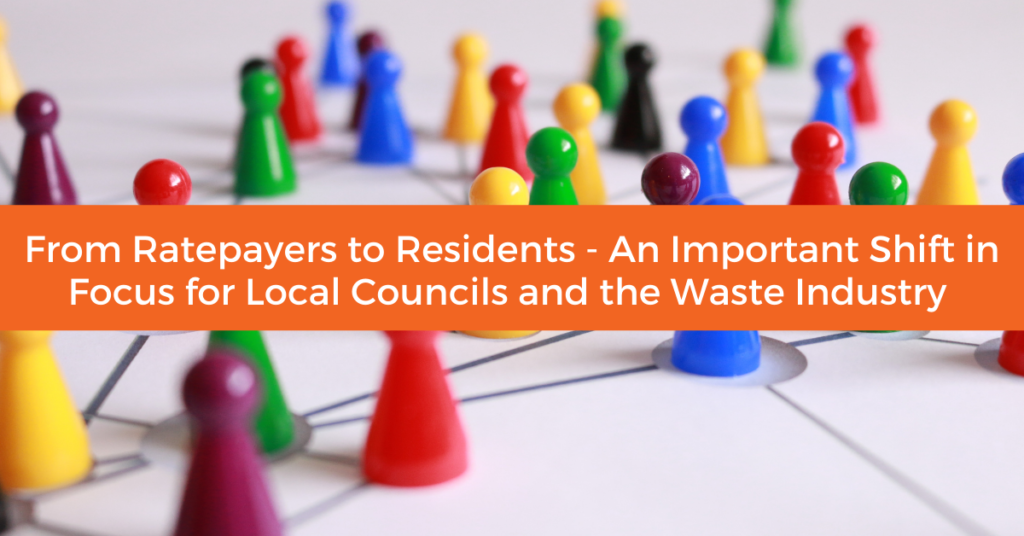
One of the three R’s local councils are known for (roads, rates and rubbish). Here at Mandalay, we know from talking to our customers that when councils ask residents about what is important to them, waste ranks up there as one of the top five issues for most communities across the country.
The challenge however is that the whole approach to waste for councils is currently driven by a cost base that comes from the waste surcharge funded as part of the rates notice. Because of this, the ratepayer is traditionally thought to be their customer, however, that is often not the case. In fact, it is the resident who lives in the property, and that isn’t always the ratepayer. Residents are also the people who elect the councillors.
While the ratepayer also being the owner occupier certainly used to be the case decades ago, these days the rise in investment properties means that a larger chunk of residents in our communities are made up of renters and not owner occupiers. The Australian Bureau of Statistics 2015–16 Survey of Income and Housing indicates that renters occupy 32% of Australian households.
What Does This Have to do With Waste?
When you think about who’s generating the waste the council is responsible for, in approximately 67% of the cases on average, it is the person living in the property who isn’t necessarily the owner and ratepayer of that property. Most of the waste comes from the occupiers, who are also your voters. The point we’re trying to make here is that the person paying the waste surcharge is not actually the same person generating the waste for that household.
So, does the council know who the person is that’s actually generating the waste material your council is responsible for?
Most councils know far less about the creators of municipal solid waste that makes up the council responsibilities in the community. A good chunk of that waste comes from residential tenants, commercial tenants, individuals living in departmental housing or even visiting tourists.
There will always be other people that make up the actual waste generators in a council’s budget, sometimes more than what is allowed for in entitlements, and so the cost of waste grows. With this in mind, the cost of the good or bad behaviour of all those other people contributing towards that waste need to be factored in, because these are actually your residents.
What Does This Change in Focus Mean for Council?
Let’s circle back to the current focus on the ratepayer and why that focus needs to shift to residents. The whole concept for council is focused on physical cost and the ratepayer, but the actual delivery costs and the optimisation of the waste services and the peripheral services that the council might offer a community is actually guided by the residents, not the ratepayers.
Where in 33% of cases the resident is not the person who owns the property, the cost of servicing that relationship is different to the relationship with the property owner. So how do you know who these residents are?
Many councillors assume they know every voter and resident, but in most cases, they don’t have the data to know who these people are. Ratepayers don’t vote but residents do. So, the pretext of this change is that everything has been built around the ratepayer because that’s the way the revenue model has been built, but it’s no longer the case with waste, which is why this shift in focus is necessary.
How is This Shift Reflected in Mandalay’s Resident Product Suite?
Here at Mandalay our Resident Product Suite has been built to handle and facilitate this shift in focus for various waste services. We have made this a focus of our Resident Product Suite because historically we’ve seen a shift over the last five years of councils wanting to offer services that affect the behaviour or the right waste behaviour of their community, and increasingly, wanting to try and shift it to the occupier of the property.
In addition, there are additional commercial and community organisations impinging on the traditional role of council waste collection. For recycling, or to make money from scrap metal, bottles, refurbishing kerbside waste and leaving only the landfill on the nature strip. These organisations are removing the value that could be realised by councils. The council also does not get the credit offset for this recycling within the community for the full landfill levy.
Every organisation has a different approach to this problem, however here at Mandalay our approach is this:
- What if we could give you the ability to build any type of relationship as well as having multiple relationships with any type of property and manage that in a way that allows you to target specific types of relationships? This would include homeowners, renters, pensioners, schools and community organisations just to name a few.
- What if we could do that digitally and then give that flexibility to your customer service team, to your community services and to your waste team, all while using the power of digital? Digital means it’s real time, it’s flexible and it’s auditable. You’ve got data around it and you can get all sorts of guidance and insights into areas of waste that traditionally you wouldn’t have even thought about historically.
How is Resident Data Obtained and Then Used in the Resident Product Suite?
Here at Mandalay, we have built and maintained a national database of over 14 and a half million properties. Depending on what you prefer, either that data can be used, or we can synchronise our information with your own property database within your council systems.
From there we can build out service offers (known as programmes in our system) for your community such as voucher programs, bulk waste, etc and you can target all or a subsection of that community. You can also deliver these services in various ways whether it be via mail, hard copy existing vouchers or through digital means. But most importantly, it gives you the auditability on that whole program.
Early adopters of the Resident Product Suite had initially thought that they wouldn’t use that data, but in reality, the data gives them powerful insights that they didn’t have previously. Once they fully utilised that data, they then started to look at optimising those services which they wouldn’t have been able to do previously in an analog scenario.
What are the Biggest Points of Value for Councils?
It all comes back to this: you can’t manage what you don’t measure. The way councils analyse waste programs currently is sub-par, and your council can do so much better with access to the right data. Having data like this gives you a power of insight and analysis that previously wasn’t possible.
For our team at Mandalay, it’s about empowering your council to deliver a better and more personalised community service to the customer at a lower cost to your council. This means:
- Being more accountable with how government money is spent for waste
- Being more accountable with the waste programs being utilised
- Being able to see exactly how these programs are used
- Being able to prevent any misuse or fraud
Reduced Fraud and Misuse – Many of these waste programs are open to misuse and currently, most councils don’t really have a way to prevent it, so they tend to ignore it. Here at Mandalay, we have seen many of our customers effectively prevent fraud that previously had gone through unmanaged.
Personalised Waste Service – When your council has access to resident data, you can really begin to target a service offering to the actual customer and even personalise the offering depending on the individual and property type. So rather than just putting out a service and seeing who takes it, your council can actually know exactly who is using that service, if they are using it and how often. They can even refine who can access a service. It can also give councils a lot more power over future programs.
Improved Customer Service – Residents will appreciate the change too. Collectively, residents will gain a more efficient customer service experience from councils when it comes to waste and the way these services are provided to the community will change too. They can expect a more transparent waste service and better service offerings to suit their specific requirements.
This shift in focus from Ratepayers to Residents is the future of how waste will be handled by local councils in Australia. If you’d like to learn more about the Resident Product Suite or would like more information on how this shift can be streamlined for your local council, please contact our team.


